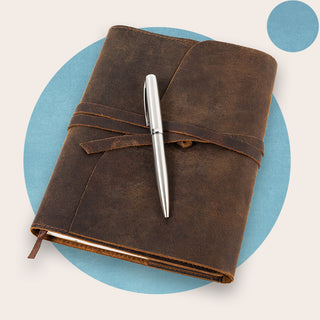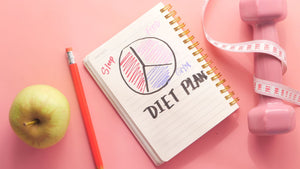Are you looking to lose a little weight? Are the other methods by which to do so not serving you as well as you might like? Are you looking for a new method that can ultimately serve you as effectively as possible?
Then step forth and saddle up as we explore seven ideas that you might include in your own weight loss journal!
1. Setting Goals & Tracking Them
Much as with any journal (like, say, a parenting journal) the common currency here is the tracking and setting of goals to achieve an end. In this way, the weight loss journal is a means to the end of your goal to lose weight. Depending on your willingness, a weight loss journal can be the meat and potatoes of your weight loss journey.
A great place to start with your own fitness journal (especially if you are struggling to know where exactly to start) is to dedicate a section to the setting and tracking of goals and ambitions. These weight loss goals can be to do with food intake or they can be to do with the amount of exercise you commit (or even both).
Losing weight is, surprisingly or unsurprisingly, a lot about flexibility, so you must learn to be flexible with yourself just as you must learn your own self. Setting health and wellness goals is one way to go about doing it. You can even do this in the manner of a bullet journal fitness tracker, using the bullet journal method to instinctively bring it all together in one place.

2. Meal Planning
Seeing as food plays a pretty key part in anyone's relationship with losing weight, it's no wonder that there is inherently some crossover between a fitness journal and what many might term a food journal or food diary.
Meal planning is one of the most important parts of losing weight, especially if you are more averse to the idea of exercise than is healthy.
So, another key part of a weight-loss journal is indeed the use of a meal planner to help you plan meals on a weekly or even monthly basis. Designing it in a way that is going to appeal to you is a methodology that should be carried through just about every single journal you own - these are, after all, expressions of yourself, no matter how utilitarian some of them might be.
For the sake of your mental health, you can even have a section where you brainstorm meal ideas before putting them up on trial for the weekly meal round-up. Those who lead a busy life might opt instead to simply throw a meal under the wheels of the oncoming week and see what happens. Remember: the choice is entirely yours!
3. Meal Logging
Alternatively, if you are not the kind of person to plan so much in advance, then you might prefer to simply keep a log of what you are eating. This will, of course, be no easy feat and there is a reason why many still prefer the seemingly more arduous task of planning meals rigorously. Keeping a journal with you at all times in this way can be a debilitating exercise, no matter how fruitful it might end up being.
Such a log will need to be incredibly specific, including, if possible, the detailed caloric content of all the things you are consuming on a daily basis so that this can then be added up by weeks and months, and then compared with how much you should seemingly be burning through other means.
Arguably more importantly, you can keep proper track of the nutritional content of all the different foods you are eating, thereby ensuring that you are getting enough of each of the requisite food groups.
If you are someone who struggles to engage with healthy habits - especially eating habits - then this could be a perfect way to get started. Any doctor worth their salt will advise it when trying to help you through something such as this.
4. Water Tracking
A key part of any effective dieter's regimen should be a regular intake of water, so any weight loss journals that are going to help you achieve your fitness goals should offer a space where you can properly keep track of your water intake.
The U.S. National Academies of Sciences, Engineering, and Medicine determined that an adequate daily fluid intake is about 15.5 cups (3.7 liters) of fluids a day for men and about 11.5 cups (2.7 liters) of fluids a day for women. That's a heck of a lot and far more than most people will ever hope to get per day, but using a proper water tracker can show you how it's done.
Some people prefer simply to include their water or fluid intake as part of their meal log, though equally some people are keen to keep these two things separate. This is your journal. Though there are scientific pieces of advice that are impossible to get around, there are choices like this that you can make that are indeed yours to make.
Ask yourself which you would prefer and adjust accordingly.

5. Workout Planning
As annoying as it might be for some, a key part of losing weight is working out and doing some exercise. It's all well and good to engage in a strict and careful dietary regimen, you are not going to properly lose weight if you don't work out and burn some of the fat that you wish to burn.
Even if you don't want to go to the gym, you must still engage in a form of physical activity, lest you waste away and die. The muscles and mind need physical stimulation in this way, even if it is only through acts like walking or light jogging.
The former is often the way many heart-attack victims are told to exercise after experiencing such an ordeal, for it provokes the act of exercise without exciting the heart or cardiovascular system too much.
Heck, physical exercise doesn't even have to be active necessarily. Yoga, pilates, tai chi, and the like all count toward such things!
In this way, a weight-loss journal can be a great way to balance your emotional eating issues by writing out a meal plan (or, indeed, keeping a meal log) while also planning out your workouts, all in one convenient place!
6. Workout Tracking
Just as you might use a weight-loss journal to plan out your workouts, you can also use it to keep track of when you work out each day. Such an exercise can be used in tandem with a planner, though it can also be used separately if you are not the kind of person who is likely to plan things ahead so much.
Here, you can simply keep track of how much you exercise, what you did, how long you did it for, as well as how intense you felt it was, all as it happens without much forethought or planning.
If you are the kind of person who foregoes intensive exercise for, say, walking or cycling everywhere as your main mode of transportation, then keep close track of how far you are traveling by foot or bike and for how long.
While you might not necessarily even do anything with this information, it is useful to have it to hand just in case you need to communicate something to, say, your personal trainer, or indeed your doctor if things take a turn for the worst. Just as good drivers have cameras installed in their cars just in case, you can never be too careful with exercise, no matter how easy-going your method might seem.
7. Mood Tracking
In this current mental health climate, the thing that should come above all else in your weight-loss journal is tracking your mood. It can be all too easy to neglect how we really feel about ourselves and our weight, especially if we are getting caught up in the cult of wanting to lose as much as possible.
It is not uncommon for the desire to lose weight to come from a largely unhealthy place where those engaging in it are trying to attain an ideal of perfection that is otherwise unattainable, though this never seems to stop them.
Thus, keeping track of your mood in relation to your weight loss has never been more important!

Final Words
So, there you have it! Hopefully, you are now feeling ready and able to get started putting together your very own weight loss journal with some or all of the ideas listed above depending on your personal preferences!
FAQs Weight Loss Journal
WHAT SHOULD BE IN A WEIGHT LOSS JOURNAL?
A weight loss journal, like any other good journal, should contain all the things that each individual user needs to help them along on their journey. In this instance, it is recommended that a weight loss journal should include a general area for setting and tracking goals, a meal planner, a meal tracker, a water tracker, a workout planner, a workout log, as well as a place to record and reflect on your mood.
DOES KEEPING A WEIGHT LOSS JOURNAL HELP?
This remains to be seen for each individual user. Though some might boast of their inherent benefits in losing weight, some have been known to cry out that such journals should be abolished, primarily because they are a weapon for the perpetuation of low self-esteem around one's body image.
HOW DO YOU MAKE A WEIGHT LOSS BULLET JOURNAL?
The most thorough way to make your own weight loss bullet journal is to make a weight loss journal and a bullet journal side-by-side and analyze the various aspects of each that work for you before combining them accordingly into one holistic piece that is uniquely personal to your own needs.
WHAT IS A WEIGHT LOSS JOURNAL?
A weight loss journal is a journal that is used for the purposes of losing weight. This can, and often does, include areas where the user can keep track of their diet, their water intake, as well as planning their exercise regimen, and general mood.



